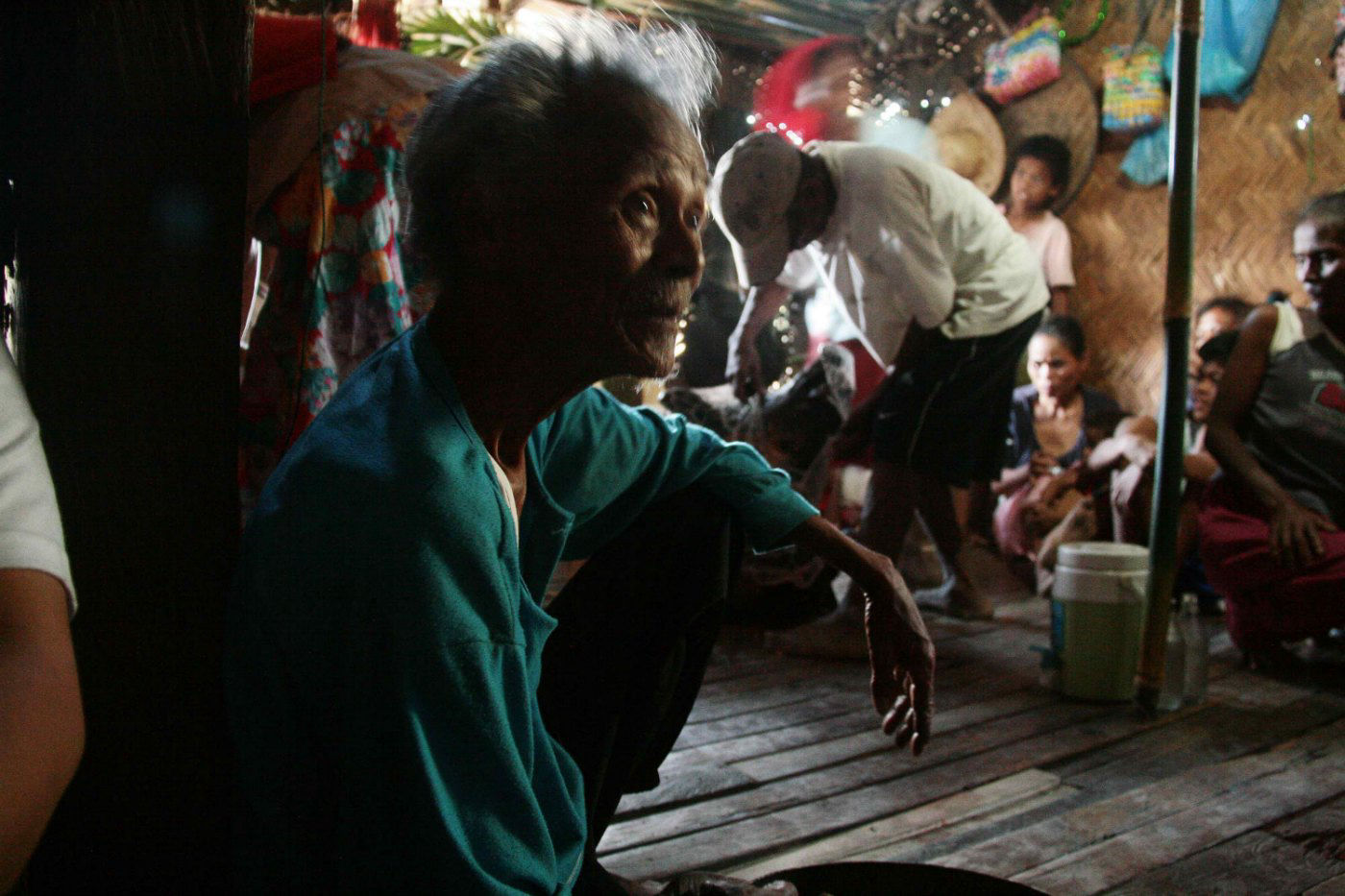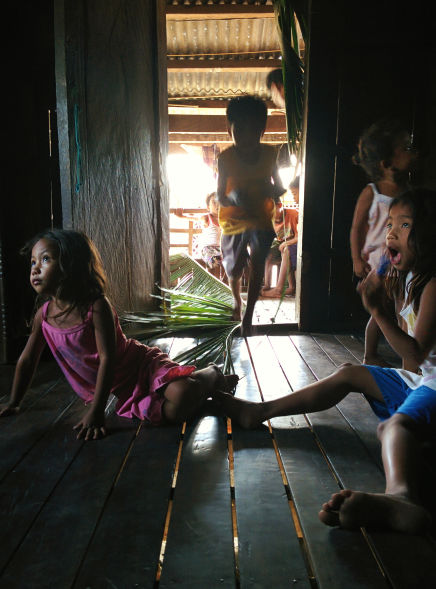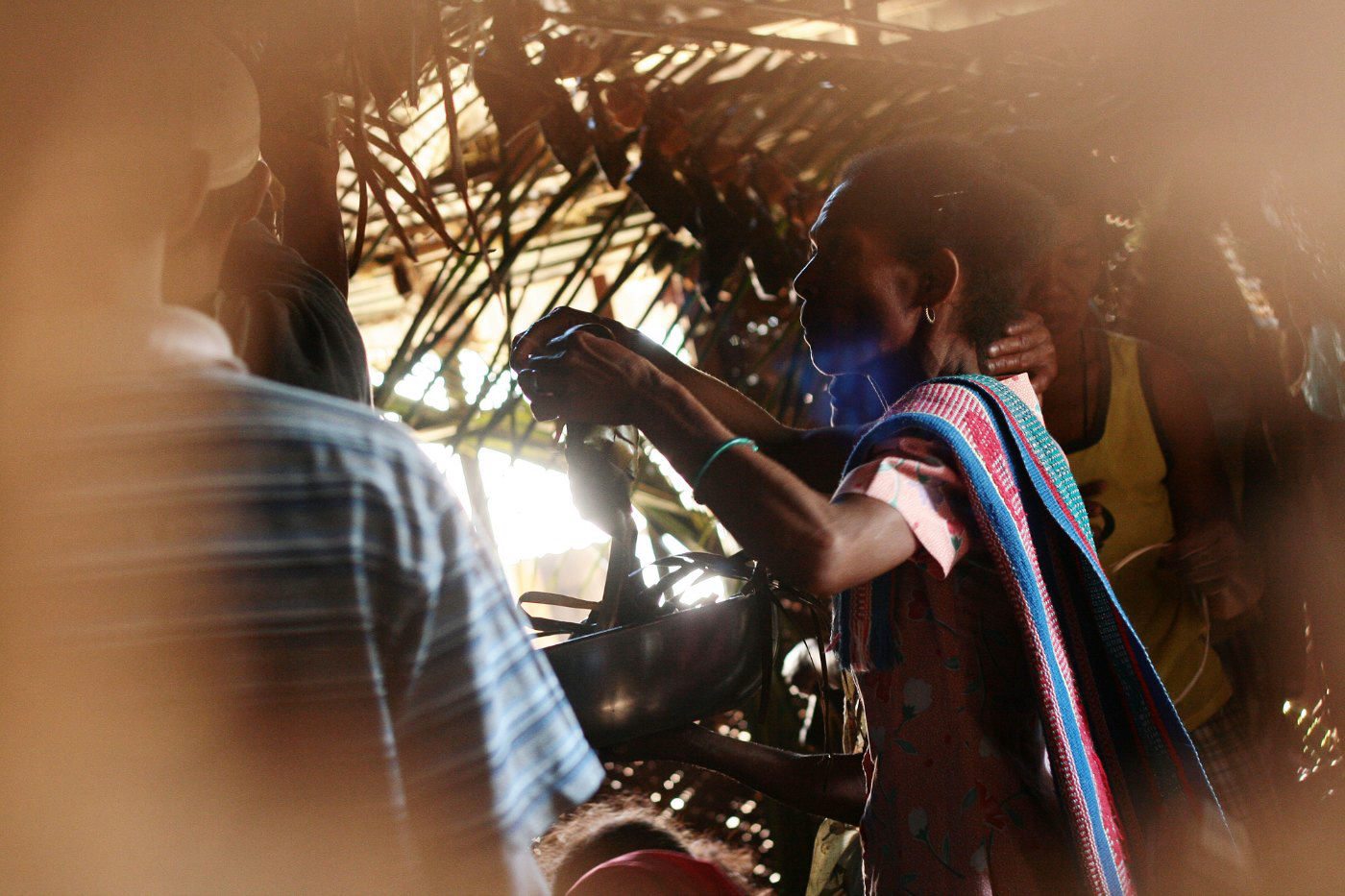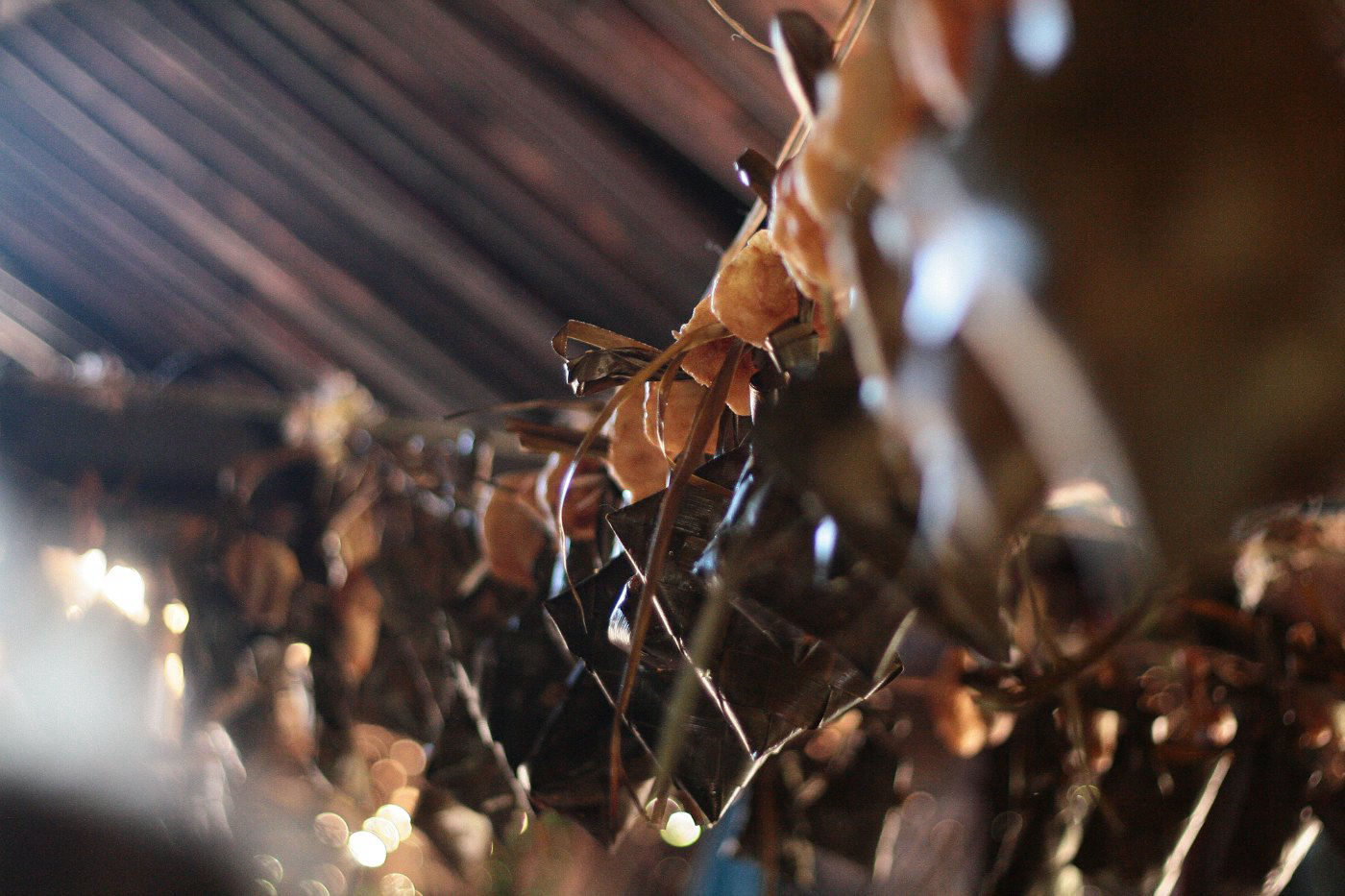
Part 3 of 3. Produced in 2014 for Kamusta? Magazine.
Words and photos by Roehl Niño Bautista. Additional shots by Joseph Angan.

Manong Johnny Basilio felt the need to clarify. While he and other members of the Abelling Tribe may be similar in skin tone, stature, and hair to their better-known neighbors in Tarlac, their vice chieftain said their customs are all their own.
Around an hour’s drive from Siesta Bus Station in Tarlac City, Sitio San Pedro is their home, with the almost 300 Ilocano-speaking families of the tribe living on agriculture.
“Minsan, kuya, wala kaming inuulam, o kaya kinakain,” 12-year-old Tenten told this writer. (“Sometimes, big brother, we don’t have anything to eat.”) The kids’ shirts were coated with a layer of dust from the unpaved road, their eyes followed our every move at Apo Totoy’s place. When we woke up on Sunday, a couple of kids played ball at the court, jumping from sacks of rice to get a better shot through the ring. Later in the afternoon, a handful of girls played badminton.
The Abelling’s Anito Festival was a pause in their daily lives: The women of the tribe prepared rice cakes and decorations while the men put up fences for the black sacrificial pig and provided music through guitars. Kids meanwhile played with toy cars, tops, and mobile phone games when they’re not running around the hut.
A bloody legacy
During the Anito Festival, a pig chosen by the spirits is to be sacrificed when the right time comes. “Dapat alagaang mabuti ang baboy, kasi kung ano ang mangyari sa kaniya, mangyayari din sa may-ari,” notes Manong Johnny. (“You need to take care of the pig because whatever happens to it will happen to the owner, too.”)
He remembers the time when the pig was hit on the head, but it was Apo Totoy who got the lump.
“Paano mo iyon mapapaliwanag?” said Manong Johnny. “Iyon ang patunay namin na totoo nga ang mga anito.” (“How else can you explain that? That’s our proof that the spirits exist.”)
That afternoon, the sacrifice was placed in a makeshift pen, with banana leaves as a partial roof to protect it from the heat. The Abelling’s Anito Festival’s continuity, it turns out, rested on this big black pig’s appetite hours before its own demise.
“Kailangan kumain yung baboy ng isa sa mga ihahain sa kaniya,” said Manong Johnny. (“The pig needs to eat at least one of the offerings.”) He adds, to our surprise: “Isipin na lang ninyo, tao dati ang alay. Kung ikaw nasa pwesto niya, makakain ka kaya?” (“Did you know the offerings were once human flesh? If you were in the pig’s place, would you be able to eat?”)

In the old days, the offering of choice was a human selected by the head anito medium. “Sasabihin ng anito kung ano ang itsura ng alay, tapos ha-huntingin na siya ng mga mandirigma.” (“The spirit would describe the offering, then based on that description, the warriors would hunt a person down.”)
The warriors of the Abelling Tribe were fierce, said Manong Johnny. But most of the time, the Abellings were caused their own deaths.
“Ang mga Abelling noon, hindi raw umaatras sa labanan. Mabuti nang mamatay kaysa kaysa iwan mo ang teritoryo mo,” he said. “Ang mga Ita daw, kapag dalawa na lang, aatras na tapos babalik na maraming kasama.” (“In the olden days, an Abelling never backed down from a battle. It was better to die than to give up your territory. Meanwhile, the Aetas would back down and gather reinforcements before charging.”)

Even their old marriage custom was also lethal, according to Manong Johnny. It involved having the woman hold a pomelo fruit to serve as a target for the man’s arrow. If he missed the suha, they won’t be married. In addition, the bride-to-be’s relatives stood behind him, ready to cut off his head if he hit the woman instead of the fruit.
“Abelling pumapatay sa kapwa Abelling,” he told our group. (“Abelling killed fellow Abelling.”) Marriages between the Aeta and Abelling were also seen as a reason behind their dwindling number.
Dangers were also external. Their town, Sitio San Pedro, was often caught between government forces and the New People’s Army until their tribe and other citizens worked to have their area declared as a peace zone.
“Dati, makikita mo sa mga bundok yung usok dahil sa pagbabakbakan nila,” recollected Manong Johnny. (“You could see smoke rising from the mountains when they were fighting.”) Gunshots and blasts were commonly heard whenever there’s an encounter.
But on the Sunday afternoon we were there, it was only the pig’s wails that echoed at Apo Totoy’s compound.

To feed a pig
The strumming and beats started again, with the female anito hosts dancing around the pig’s bamboo pen, hitting the pig with leaves to make it angry.
The pig would then be released, and one man would be chosen to lead the pig’s capture. “Mapalad ka kung ikaw ang mapili,” said Manong Johnny. “Hindi ka pwedeng tumanggi.” (“You’re lucky if you’re chosen to chase the pig. You can’t say no.”)
Another local was chosen, diving for the pig as the banging and chanting grew louder. They tied the pig upside down and circled it around Apo Totoy’s hut five times before pinning it down on his doorstep.

Then after a long wait, the women elders carried yesterday’s rice cakes, yam, and other delicacies stabbed on a piece of bamboo. If the pig didn’t eat anything, the weekend’s Anito Festival would be the last.
One by one, a piece of food was placed next to the mouth of the pig. When Manong Johnny said that it had to eat for the festival to continue, we thought it would be offered its potential last meal inside its cage, not being forced to eat while lying down.
The pig refused to eat, spitting out rice cake after rice cake.
Onlookers sighed at every failed attempt, with each try becoming more of a force-feeding affair with the food being forced deeper down its throat.
After around twenty minutes, the pig still hadn’t eaten anything

‘So that my children will know their roots’
Aside from the red bandana and sash worn by the elder women, the gong that a small girl kept playing, and the unorthodox dancing accompanied by strumming… the rest of the Anito festival looked relatively contemporary.
The tribal musical strings came not from a strange-looking instrument, but from your standard-looking eight-shaped guitar; Mang Berting wore an Ateneo de Manila University t-shirt when he carried bamboo and decorations inside the hut; teens from the tribe took photos with their mobile phones; and they sought the intercession of Ginebra San Miguel gin when they tried to summon a long-lost anito in the evening.
Except for a native guitar owned by one of the elders, other Abelling-tribe-unique instruments are gone.
“Ang ugali kasi nila, halimbawa ako ang may-ari ng gamit, kapag namatay ako lahat ng gamit ko ililibing,” Manong Johnny explained to us. (“When someone dies, the tradition is to bury all this possessions with him.”)
This festival is one that he hopes won’t be lost with the death of the ageing anito hosts. But whether this traditional celebration lives on or not was up to the spirits.
The vice chieftain, who also hosts mountaineers at his home, talked of his notebooks filled with sketches of the Abelling’s lost artifacts.

“Kapag tinatanong ko yung matanda halimbawa tungkol sa mga itak nila noon, pag-ine-explain niya sa akin, dino-drawing ko naman,” said Manong Johnny. “‘Ganito po ba?’ Ipapakita ko yung hugis ng drawing habang nagkukwento siya.” (“I ask the elders what the old tools look like. ‘Is this right?’ I try to sketch the objects as they tell me stories.”)
He would ask for specifics: “‘Ilang dangkal ba siya, gaano kanipis, gaano siya kalapad?’ Para kapag nagpagawa ako halimbawa [ng replica] ayon sa [description ng] mga matatanda, susundin ko yung pagkakasabi niya.” (“I ask, ‘How long is it? How thin? How wide?’ That way, I can have replicas made based on the elders’ descriptions.”)
We asked for a peek, but we were told such items were kept in a chest by the elders and a different ceremony is required before it is opened. Even the simple act of having an outsider acquire their traditional tattoo needs permission from the elders.
Manong Johnny had to vouch for photojournalist Dax Simbol to get his “souvenir tattoo”: a mark which involves scarring, not inking, and looks more like cigarette burn marks than anything close to the works of Apo Fang-od of Kalinga. “Kung sakaling ito na ang huling festival, malaki ang kahalagahan ng pagpapa-tattoo namin ngayon,” said Manong Johnny. (“If ever this turns out to be our last festival, the tattoos done during the festival become even more priceless.”)
Worst case scenario? At least he has visual proof that their traditions once existed. Best case scenario? The photos and videos will help them keep traditions alive for generations to come.
“Kaya gusto ko ma-document natin (yung festival), pwede naming i-replika na lang ‘yung ginagawa,” adds Mang Johnny. “Para alam ng anak ko kung ano ang pagkakakilanlan niya bilang Abelling.” (“That’s why I want us to document this festival, so we can replicate the traditions in the future. So that my children will know their roots as Abelling.”)
Just then, and to the joy of the onlookers, the pig didn’t spit out one of the last dishes offered. It then devoured the next one without being forced. An assistant got a sharpened bamboo and drove it through the pig’s side. One by one, the females stooped down to drink blood from the pig, the same thing Apo Totoy did earlier to a pig prepared for lunch.

The sacrifice met its end, charred and cut into half after, with its upper part displayed inside the hut and its bottom sliced into rings. With the pig’s death, the Abelling Festival will continue.
Aftermath
One month after the 2014 Abelling Festival ended, we got in touch with Manong Johnny through Alvin of Kultura Kamp, our guide during the trip to Tarlac. Here’s what he told us.
The elders decided which among the two women who fed the sacrificial pig would be responsible for the next Anito Festival. Ka Freddie’s wife was chosen, which meant that he, in effect, takes Apo Totoy’s place as host of the celebration. Ka Freddie has already begun taking care of a piglet.
As for Mang Berting’s lost anito, “pagala-gala pa rin daw kasi hindi sumanib sa kaniya.” (“The spirit is somewhere out there because it did not posses him.”) But he’s no longer in harm’s way as previously feared since Apo Totoy’s son promised to be its new host when the time comes.
Until then, Apo Totoy remains the head of the tribe.
Part 1
Part 3
Mobirise web builder - Try here